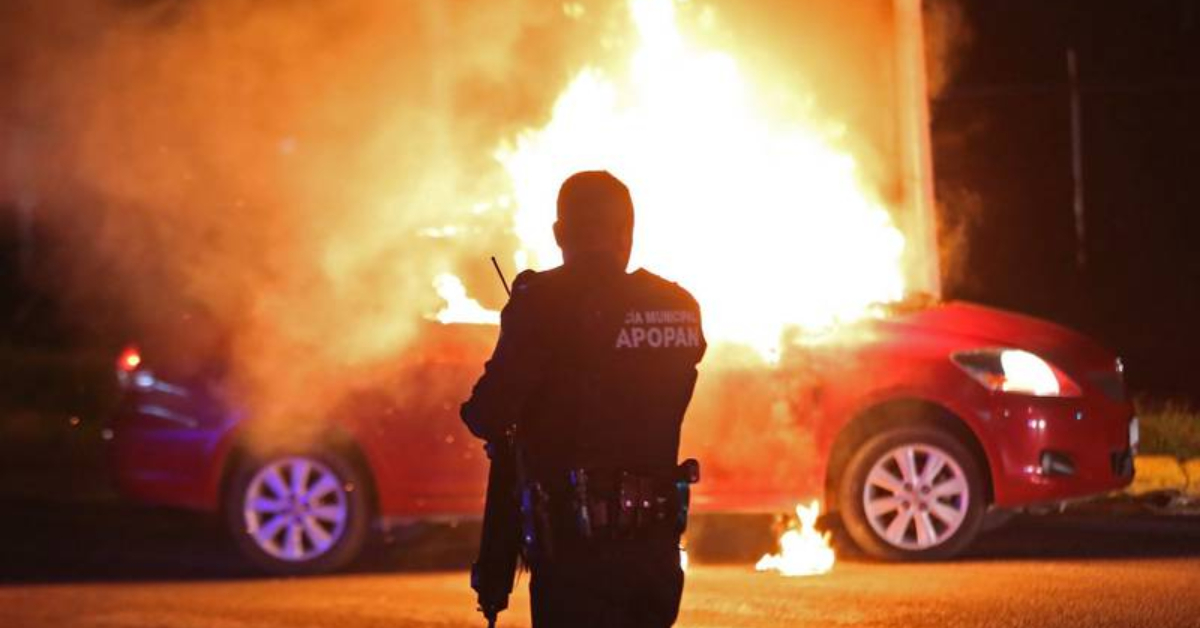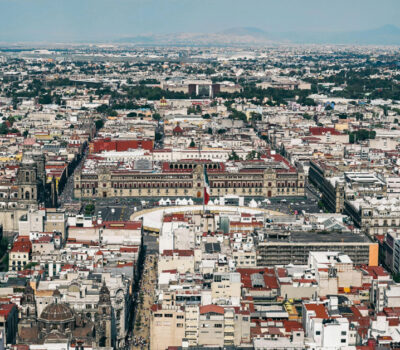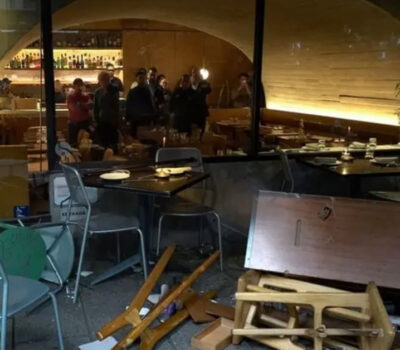President Andrés Manuel López Obrador has held the public policy of what he calls ‘Hugs, not bullets’ in his passive approach to organized crime, a policy that has failed, although the President still stands next to his love, not war, approach to organized crime, even after three days of narco-terrorism.
Mexico added three days of violence against civil society in Jalisco, Guanajuato, Chihuahua, and Baja California this week.
On Tuesday night, armed men set fire to 25 Oxxo stores, blocked streets, and sparked shootings in Jalisco and Guanajuato.
According to the President, Andrés Manuel López Obrador, the violence in Jalisco and Guanajuato was “because apparently there was a meeting, a meeting of two gangs, and elements of the Defense arrived, there was a confrontation and arrests, this was what caused the vehicle burning”.
The driver of a trailer was shot dead while trying to evade a group of armed men who were burning vehicles on the federal highway Irapuato-Abasolo 1110, during the arson riots registered in Guanajuato on Tuesday night and early Wednesday morning.
In Jalisco, apparently, no civilians were killed that day. However, the violence continued on Thursday in Ciudad Juárez, Chihuahua, where a fight between prisoners of “Los Chapos” and “Los Mexicles” left two dead, but spread to the streets.
Juarez was where more innocent people died from the violence unleashed by criminal groups this week, in the attacks on Oxxos and a pizzeria.
A 12-year-old boy died in a convenience store, he was first injured in an armed attack at a Circle K in the Reforma neighborhood, however, his death was reported later that night.
The others occurred in an Oxxo where two women died, another person died on Teófilo Borunda Avenue, four more in the pizzeria, plus the deceased from Cereso and other people in various parts of the city.
Yesterday, Friday, the violence returned to Guanajuato when blockades were recorded on roads and highways with burning vehicles in the municipalities of Celaya and Salvatierra, Juventino Rosas, Guanajuato.
Preliminarily, security elements attributed the fires to the reaction of a criminal group for the arrest of one of its leaders in a police operation.
In the Geovillas de los Sauces de Celaya subdivision, a man died in a shooting.
Security elements responded to complaints about blockages on the Celaya-Comonfort highway, in the section from the community to Empalme Escobedo, and about the burning of a truck in the Río Grande neighborhood, in Juventino Rosas.
And in addition to Guanajuato, Baja California also suffered from drug violence when armed individuals set fire to public transport units this Friday evening at different points in at least three of the main municipalities of Baja California: Tijuana, Mexicali, and Ensenada.
“I condemn the violent acts that occurred this afternoon in our state. At this moment I am meeting with the Security Table,” said the state governor, Marina del Pilar Ávila Olvera (Morena), on her Twitter account.
“This is not an assault, we are simply going to set the unit on fire,” a witness to the events who was aboard a transport unit that was set on fire told Foro TV. He said that the armed subjects stopped the unit, asked passengers to exit the bus, and burned the vehicle.
Throughout the week, citizens were affected by the violence generated by armed groups, which can be considered narco-terrorism.
What is narcoterrorism?
The term is used for armed groups and criminal organizations that produce and distribute drugs that use violence against the civilian population, by themselves or in alliance with other cells.
Colombian Luis Alberto Villamarín Pulido, in his book Narcoterrorism: The War of the New Century, defines this phenomenon as a “global threat” that adds up to a “lethal triangle” of drugs, arms trafficking, and terrorism.
In turn, he points to terrorism as an economic system developed since the Second World War and divided into three phases. “The first was the terrorism sponsored by some states during the cold war, by financing armed groups including in Latin America. The second phase was the privatization of terrorism in the 1970s and 1980s, when Eta, Ira, and OLP financed themselves. The third stage is when western capitalism expands and with it the economy of terrorism”, says Villamarín.
Villamarín was a colonel in the Colombian Army, one of the countries in which narco-terrorism plagued civil society since the time Pablo Escobar established the Medellín cartel.
During that time the car bombs, the explosives in airplanes, and the massive kidnappings of politicians sowed panic in Colombian society in the 1980s and 1990s. In addition, that added to the paramilitarism left thousands dead, disappeared, and displaced.
However, Colombia has not been the only country that has suffered from narco-terrorism. Various voices point out that groups like Sendero Luminoso in Peru are also a case of this phenomenon.
Is there cartel terrorism in Mexico?
In Mexico, the so-called war against drug trafficking that Felipe Calderón officially began in 2006 and continues to this day has left thousands dead.
In the conflict, there have been nine cases of car bombs, one of the most disastrous and representative acts of narco-terrorism.
In the country, it is increasingly common for criminal groups to block highways and streets with burning vehicles to block the path of the authorities, use the population as a human shield, or leave civilians in the middle of the confrontation.
Most of the acts carried out in Mexico are revenge for the capture of crime leaders. Cartels have successfully created a narco-state in most of Mexico by using violence and terrorism to bring the government into submission. Narco-terrorism is destructive to Mexico’s economy which greatly depends on foreign travel and investment, and cartels use that to leverage their power over the government.
President Andrés Manuel López Obrador has held the public policy of what he calls 'Hugs, not bullets' in his passive approach to . . .












